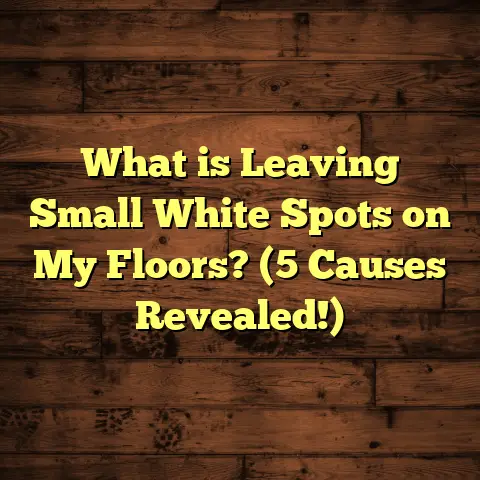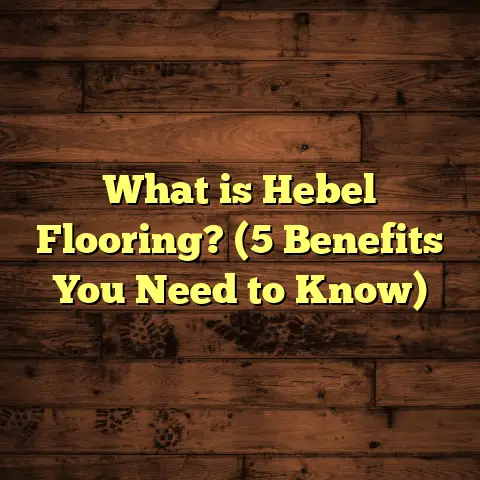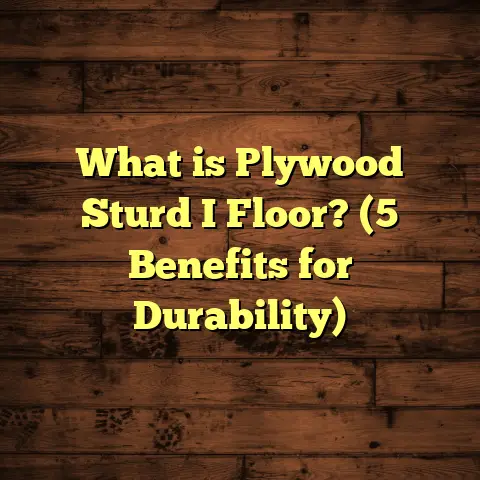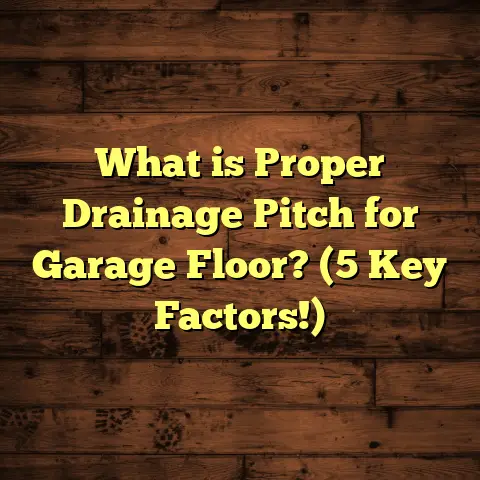What is Pebble Flooring? (5 Reasons It’s Costlier Explained)
Have you ever stood in a space and wondered what makes that floor so unique—not just pretty, but somehow alive, textured, and natural? Maybe you walked barefoot on it and felt something different under your feet—like a soft, gentle massage that connects you with nature. If this sounds like something you’d want for your home or outdoor area, pebble flooring might be what you’re imagining. But then, when you start checking prices, you realize it’s a bit more expensive than what you expected. Why is that?
I’ve worked with many clients who love the look and feel of pebble floors but hesitate because of the cost. So let’s chat about what pebble flooring really is, what makes it special, and why it tends to be pricier than other flooring options. I’ll also share stories from my own projects and data to help you understand every aspect of this fascinating flooring type.
What is Pebble Flooring?
Pebble flooring is a type of decorative flooring made by embedding small, smooth stones or pebbles into a base material like concrete, resin, or specialized adhesives. The pebbles are often natural river stones or polished stones that create a textured surface. This flooring is popular for its natural aesthetics, durability, and slip resistance.
When I first encountered pebble flooring years ago, I was drawn by its organic, earthy feel. Unlike flat tiles or slick vinyl surfaces, pebble floors seem to tell a story—each stone with its own shape and color, arranged like little jewels beneath your feet.
Technical Definition
From a technical standpoint, pebble flooring is a form of “exposed aggregate” flooring. Exposed aggregate means the surface layer reveals the embedded stones instead of covering them with grout or mortar entirely. This creates a rough texture with both functional and aesthetic benefits.
Here’s how it works technically:
- Pebbles range in size from about 4mm to 20mm in diameter.
- They must be smooth and rounded to avoid sharp edges.
- The base layer is usually a concrete slab or resin system.
- Pebbles are embedded into a freshly poured base before it fully cures.
- After curing, the surface is ground down to reveal the stones’ tops and then sealed.
Manufacturing and Installation Process
The manufacturing and installation of pebble floors require precision and care. The process typically involves:
- Site Preparation: The existing floor or ground is cleaned, leveled, and sometimes reinforced. I’ve seen installations fail or crack when this step was rushed.
- Mixing Base Material: Depending on the project, either a concrete mix (cement + sand + water) or a resin base (epoxy or polyurethane) is prepared.
- Pebble Selection & Sorting: Pebbles are sorted by size, color, and smoothness. This can be quite time-consuming if you’re aiming for a consistent look.
- Placement of Pebbles: There are two main methods:
- Broadcasting: Throwing pebbles over the wet base.
- Hand Placement: Arranging pebbles one by one for patterns or specific designs.
- Compaction/Embedding: Pebbles are pressed gently into the base to anchor them.
- Grouting or Filling: Spaces between pebbles are filled with grout or resin to lock everything in place.
- Grinding & Polishing: The surface is ground to remove excess grout and polish the stones flush with the surface.
- Sealing: A protective sealant is applied to prevent stains and moisture damage.
Each step requires attention to detail, skill, and patience—something I’ve learned firsthand after years of working with different substrates and environments.
What Makes Pebble Flooring Cost More? Five Key Reasons
When I quote pebble flooring jobs, clients usually ask: “Why does this cost more than tile or vinyl?” Here’s what I tell them based on experience and data.
1. Material Sourcing — Quality Stones Aren’t Easy to Find
Not all pebbles are created equal. High-quality river stones need to be:
- Smooth and rounded
- Durable against wear
- Consistent in size for uniformity
- Free from cracks or impurities
Many suppliers source pebbles from natural riverbeds or quarries known for specific stone types. Some pebbles are polished further to enhance color or smoothness, which adds processing time and cost.
For example, in one coastal project, we sourced white quartz pebbles from a remote quarry hundreds of miles away because local stones didn’t match the client’s vision. The transport and handling cost bumped up the material price by nearly 25%.
Natural stone prices fluctuate due to availability, extraction restrictions, and transportation logistics. Some specialty colors or sizes command higher prices.
Here’s some data to give you an idea:
| Material Type | Cost per sq ft (USD) |
|---|---|
| Standard River Pebbles | $3 – $6 |
| Polished Quartz Pebbles | $5 – $9 |
| Specialty Colored Stones | $7 – $12 |
These costs exclude the base materials like cement or resin but give a clear picture of how stone quality impacts the price.
2. Labor Intensity — Skilled Hands Take Time
Installing pebble flooring isn’t as simple as pouring concrete or laying tile sheets. It demands:
- Skillful placement of stones for even coverage
- Careful attention to pattern and spacing
- Extended installation time compared to standard floors
From my experience managing crews, pebble floors can take three to four times longer per square foot than regular tile floors because every pebble placement affects the final texture and structural integrity.
One memorable job took almost two weeks for just 600 sq ft because we hand-arranged specific stones for a mosaic pattern requested by the client. Labor costs were understandably high due to the time commitment.
On average:
| Flooring Type | Installation Time (hrs per 100 sq ft) |
|---|---|
| Tile | 8-10 |
| Vinyl Sheet | 4-6 |
| Pebble Flooring | 20-30 |
Labor rates vary but typically range around $40-$70/hr depending on location and expertise level.
3. Surface Prep & Finishing — Precision Adds Cost
The subfloor must be perfectly clean and level before installation begins; otherwise, cracks or unevenness can develop later.
After placing the pebbles:
- Grouting between stones must be done carefully without covering their tops.
- Grinding smooths the surface but requires specialized grinders.
- Polishing brings out pebble colors.
- Sealing protects against stains and moisture but needs periodic reapplication.
I recall one project where poor surface prep led to cracking within months, forcing costly repairs and resealing. Since then, I always emphasize thorough prep as part of the project timeline and budget.
Specialized equipment rental for grinding and polishing can cost between $150-$400 daily depending on machine size and power.
4. Long-Term Durability & Maintenance Benefits
Pebble flooring is surprisingly durable compared to many alternatives. Once installed correctly:
- It resists abrasion very well.
- It doesn’t easily chip or crack under moderate foot traffic.
- It’s naturally slip-resistant due to texture.
Clients who invest upfront save on replacements or repairs later.
For example, a commercial restaurant floor I worked on has been standing strong for over eight years despite heavy daily foot traffic and spills. Cheaper vinyl floors nearby showed significant wear within two years.
Maintenance involves:
- Cleaning with mild detergents
- Occasional sealing every 2–3 years depending on use
This maintenance requirement is low compared to other natural stone floors that need constant polishing or refinishing.
5. Customization & Aesthetic Value
One reason I love working with pebble floors is their design flexibility:
- Different colored pebbles create unique patterns.
- Mixing stone types adds texture depth.
- Integration with wood or tile allows creative transitions.
Custom designs often require trial runs, mockups, and extra labor time—not just laying random stones.
For instance, one client wanted an ocean-themed mosaic for their bathroom floor using blue and white pebbles arranged like waves—a design that took several days just in layout planning before installation began.
These customizations elevate the floor from functional to artistic but naturally increase costs through:
- Design consultation fees
- Higher labor hours
- Increased material waste due to pattern complexity
More Insights From My Projects
I want to share some detailed cases that highlight these cost factors in real settings:
Beachfront Villa Project
A client wanted a seamless indoor-outdoor flow with natural pebble flooring connecting their living room to the patio.
We used locally sourced river pebbles sorted for size consistency. The installation took 12 days for about 500 sq ft due to pattern layout and multiple polishing passes.
Costs broke down as follows:
| Cost Component | Estimated Cost (USD) |
|---|---|
| Materials (pebbles + base) | $3,000 |
| Labor | $4,500 |
| Equipment Rental | $600 |
| Sealants & Finishing | $400 |
| Total | $8,500 |
The client was happy with the durability during tropical rains and praised how natural textures prevented slips when wet.
Commercial Spa Flooring
Another project was a high-end spa wanting pebble floors in treatment rooms for therapeutic foot reflexology effects.
We selected polished quartz pebbles for smoothness yet firmness underfoot. The layout involved hand-placement for specific zones targeting pressure points.
Installation took longer due to intricate zones needing careful grinding and sealing multiple times.
Costs were higher due to specialized stone but justified by client satisfaction and spa branding uniqueness.
Additional Technical Details
To understand why pebble flooring costs more technically:
Base Material Variations
- Concrete Base: Strong but requires longer curing (7–28 days). Good for outdoor use.
- Epoxy Resin Base: Faster curing (24–48 hrs), chemical resistant but less UV stable outdoors.
- Polyurethane Resins: Flexible; good for areas subject to temperature changes.
Choosing the right base depends on:
- Location (indoor/outdoor)
- Traffic load
- Moisture exposure
Pebble Grading & Sorting
Pebbles must be graded by size uniformity—for example:
- Fine grade: 4–8 mm
- Medium grade: 8–15 mm
- Coarse grade: >15 mm
Proper grading ensures even texture without sharp protrusions which can cause discomfort or safety issues.
What You Should Know Before Choosing Pebble Flooring
If you’re seriously considering pebble flooring for your home or commercial space, here are some practical tips:
- Expect Higher Initial Investment: It pays off long-term but budget accordingly.
- Choose Quality Materials: Don’t compromise on stone quality; it affects durability.
- Hire Experienced Installers: Skill matters more than speed here.
- Plan for Maintenance: Sealing every few years keeps floor looking fresh.
- Design Thoughtfully: Use customization wisely—it adds value but also cost.
- Location Matters: Outdoor areas may require more UV-resistant bases.
- Consider Subfloor Condition: Poor subfloor means costly repairs later.
- Request Samples: Always see actual pebble samples before committing.
- Prepare for Longer Installation: Be patient; quality takes time.
- Ask About Warranty: Reputable installers offer warranties covering workmanship.
Final Thoughts: Is Pebble Flooring Worth It?
I often tell clients that pebble flooring isn’t just flooring—it’s part of your environment’s personality. Yes, it costs more than typical tile or laminate floors but offers:
- Unique natural beauty
- Slip resistance perfect for wet zones
- Longevity outperforming cheaper options
- Design versatility not easily matched elsewhere
If you appreciate craftsmanship and don’t mind investing upfront for something truly special underfoot, pebble flooring can transform your space beautifully.
Have questions about specific projects or want advice on sourcing materials? Feel free to ask—I’m here to help with all things floor-related!





